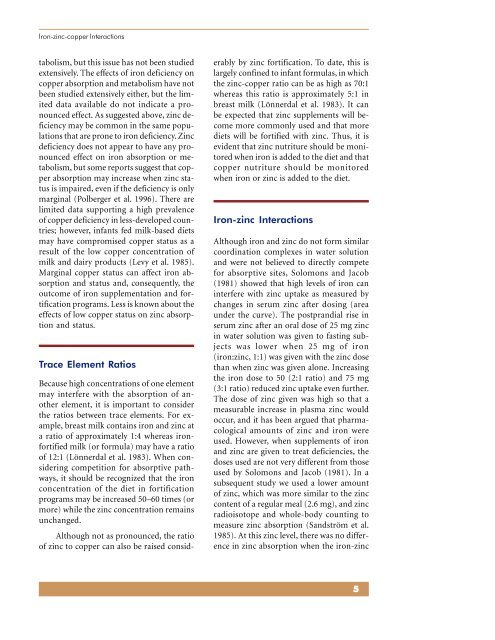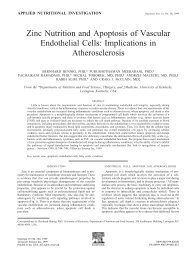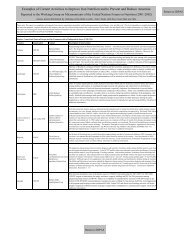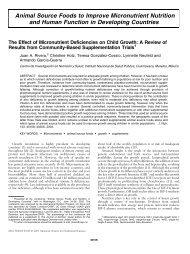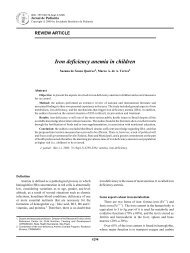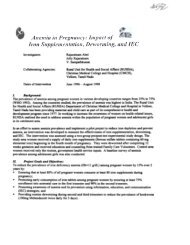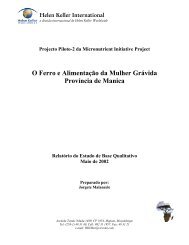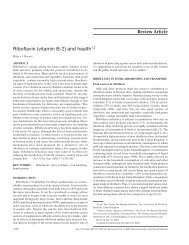Micronutrient Interactions: Impact on Child Health and ... - Idpas.org
Micronutrient Interactions: Impact on Child Health and ... - Idpas.org
Micronutrient Interactions: Impact on Child Health and ... - Idpas.org
You also want an ePaper? Increase the reach of your titles
YUMPU automatically turns print PDFs into web optimized ePapers that Google loves.
Ir<strong>on</strong>-zinc-copper <str<strong>on</strong>g>Interacti<strong>on</strong>s</str<strong>on</strong>g><br />
tabolism, but this issue has not been studied<br />
extensively. The effects of ir<strong>on</strong> deficiency <strong>on</strong><br />
copper absorpti<strong>on</strong> <strong>and</strong> metabolism have not<br />
been studied extensively either, but the limited<br />
data available do not indicate a pr<strong>on</strong>ounced<br />
effect. As suggested above, zinc deficiency<br />
may be comm<strong>on</strong> in the same populati<strong>on</strong>s<br />
that are pr<strong>on</strong>e to ir<strong>on</strong> deficiency. Zinc<br />
deficiency does not appear to have any pr<strong>on</strong>ounced<br />
effect <strong>on</strong> ir<strong>on</strong> absorpti<strong>on</strong> or metabolism,<br />
but some reports suggest that copper<br />
absorpti<strong>on</strong> may increase when zinc status<br />
is impaired, even if the deficiency is <strong>on</strong>ly<br />
marginal (Polberger et al. 1996). There are<br />
limited data supporting a high prevalence<br />
of copper deficiency in less-developed countries;<br />
however, infants fed milk-based diets<br />
may have compromised copper status as a<br />
result of the low copper c<strong>on</strong>centrati<strong>on</strong> of<br />
milk <strong>and</strong> dairy products (Levy et al. 1985).<br />
Marginal copper status can affect ir<strong>on</strong> absorpti<strong>on</strong><br />
<strong>and</strong> status <strong>and</strong>, c<strong>on</strong>sequently, the<br />
outcome of ir<strong>on</strong> supplementati<strong>on</strong> <strong>and</strong> fortificati<strong>on</strong><br />
programs. Less is known about the<br />
effects of low copper status <strong>on</strong> zinc absorpti<strong>on</strong><br />
<strong>and</strong> status.<br />
Trace Element Ratios<br />
Because high c<strong>on</strong>centrati<strong>on</strong>s of <strong>on</strong>e element<br />
may interfere with the absorpti<strong>on</strong> of another<br />
element, it is important to c<strong>on</strong>sider<br />
the ratios between trace elements. For example,<br />
breast milk c<strong>on</strong>tains ir<strong>on</strong> <strong>and</strong> zinc at<br />
a ratio of approximately 1:4 whereas ir<strong>on</strong>fortified<br />
milk (or formula) may have a ratio<br />
of 12:1 (Lönnerdal et al. 1983). When c<strong>on</strong>sidering<br />
competiti<strong>on</strong> for absorptive pathways,<br />
it should be recognized that the ir<strong>on</strong><br />
c<strong>on</strong>centrati<strong>on</strong> of the diet in fortificati<strong>on</strong><br />
programs may be increased 50–60 times (or<br />
more) while the zinc c<strong>on</strong>centrati<strong>on</strong> remains<br />
unchanged.<br />
Although not as pr<strong>on</strong>ounced, the ratio<br />
of zinc to copper can also be raised c<strong>on</strong>sid-<br />
erably by zinc fortificati<strong>on</strong>. To date, this is<br />
largely c<strong>on</strong>fined to infant formulas, in which<br />
the zinc-copper ratio can be as high as 70:1<br />
whereas this ratio is approximately 5:1 in<br />
breast milk (Lönnerdal et al. 1983). It can<br />
be expected that zinc supplements will become<br />
more comm<strong>on</strong>ly used <strong>and</strong> that more<br />
diets will be fortified with zinc. Thus, it is<br />
evident that zinc nutriture should be m<strong>on</strong>itored<br />
when ir<strong>on</strong> is added to the diet <strong>and</strong> that<br />
copper nutriture should be m<strong>on</strong>itored<br />
when ir<strong>on</strong> or zinc is added to the diet.<br />
Ir<strong>on</strong>-zinc <str<strong>on</strong>g>Interacti<strong>on</strong>s</str<strong>on</strong>g><br />
Although ir<strong>on</strong> <strong>and</strong> zinc do not form similar<br />
coordinati<strong>on</strong> complexes in water soluti<strong>on</strong><br />
<strong>and</strong> were not believed to directly compete<br />
for absorptive sites, Solom<strong>on</strong>s <strong>and</strong> Jacob<br />
(1981) showed that high levels of ir<strong>on</strong> can<br />
interfere with zinc uptake as measured by<br />
changes in serum zinc after dosing (area<br />
under the curve). The postpr<strong>and</strong>ial rise in<br />
serum zinc after an oral dose of 25 mg zinc<br />
in water soluti<strong>on</strong> was given to fasting subjects<br />
was lower when 25 mg of ir<strong>on</strong><br />
(ir<strong>on</strong>:zinc, 1:1) was given with the zinc dose<br />
than when zinc was given al<strong>on</strong>e. Increasing<br />
the ir<strong>on</strong> dose to 50 (2:1 ratio) <strong>and</strong> 75 mg<br />
(3:1 ratio) reduced zinc uptake even further.<br />
The dose of zinc given was high so that a<br />
measurable increase in plasma zinc would<br />
occur, <strong>and</strong> it has been argued that pharmacological<br />
amounts of zinc <strong>and</strong> ir<strong>on</strong> were<br />
used. However, when supplements of ir<strong>on</strong><br />
<strong>and</strong> zinc are given to treat deficiencies, the<br />
doses used are not very different from those<br />
used by Solom<strong>on</strong>s <strong>and</strong> Jacob (1981). In a<br />
subsequent study we used a lower amount<br />
of zinc, which was more similar to the zinc<br />
c<strong>on</strong>tent of a regular meal (2.6 mg), <strong>and</strong> zinc<br />
radioisotope <strong>and</strong> whole-body counting to<br />
measure zinc absorpti<strong>on</strong> (S<strong>and</strong>ström et al.<br />
1985). At this zinc level, there was no difference<br />
in zinc absorpti<strong>on</strong> when the ir<strong>on</strong>-zinc<br />
5


